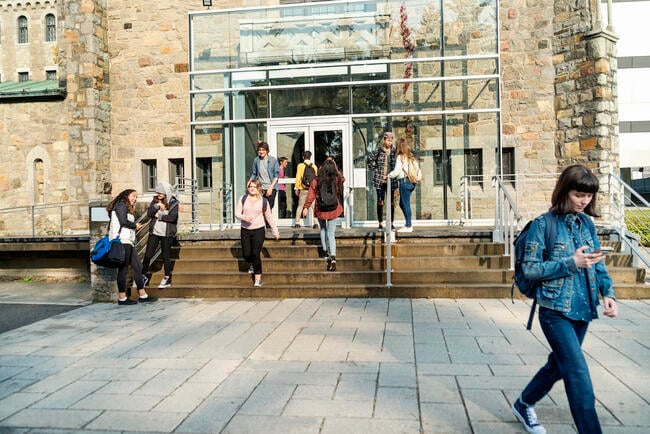You have /5 articles left.
Sign up for a free account or log in.

A majority of college students experienced some form of financial hardship and basic needs insecurity in the past year, according to data from Trellis Strategies.
martindoucet/E+/Getty Images
Nearly half of college students say their current financial situation makes it difficult to concentrate on their coursework, according to a recent survey by Trellis Strategies.
The fall 2024 Student Financial Wellness Survey highlights how student concerns about college affordability play a role not just in their enrollment but also in their retention and economic mobility after graduation.
The survey, which Trellis publishes annually, also illuminates a mismatch between available institutional supports and students’ utilization of resources. Sixty-four percent of students at two-year colleges and 54 percent of those at four-year colleges said their institution had the necessary resources to assist with their financial situation, but only 38 percent of respondents said they thought their institution was aware of their financial situation.
Financial fragility: College students are known for living on shoestring budgets, but survey respondents highlighted the precarious financial situation many find themselves in.
Fifty-six percent of respondents said they would have trouble obtaining $500 in cash or credit to pay for an unexpected expense. Past research shows that students of certain identities are more likely to experience financial difficulty, including Black and Latino students and women of all racial and ethnic backgrounds.
Nearly three-fourths (71 percent) of respondents said they had experienced financial trouble while enrolled in college, and 68 percent said they ran out of money at least once since the beginning of the calendar year. One in five respondents said they had run out of money eight times between Jan. 1, 2024, and the fall, when the survey was conducted.
On average, students said they rely on 2.9 difference sources to fund their education—including scholarships, grants, loans, savings, income and contributions from family. Only 5 percent of respondents are “self-financing” their education, using a combination of current income and savings; one-third of respondents have taken out student loans to pay for college.
Of students utilizing loans, over half had more debt than they expected, and a majority expressed low confidence in their ability to repay their student loan debt.
Basic needs: Almost three in five respondents grappled with basic needs insecurity in the previous 12 months, on par with the Hope Center’s latest data. Around 44 percent of students were food-insecure, 43 percent experienced housing insecurity and 14 percent were homeless. Over half (58 percent) of respondents experienced one or more forms of basic needs insecurity.
Some respondents used public assistance programs, including food assistance (15 percent) and medical assistance (20 percent), to make ends meet, but research shows that a lack of awareness and limited eligibility opportunities for college students impedes participation in public assistance programs.
Specific student groups were more likely to be affected by basic needs insecurity, including low-income learners, first-generation students, parenting students and former foster care youth.
A new type of student: As higher education becomes increasingly diverse, the characteristics of students enrolled and the challenges they face are evolving, as well.
Today’s learners continue to report high levels of mental health challenges. One-third of respondents said they’d experienced symptoms of major depressive disorder, and 44 percent exhibited signs of generalized anxiety disorder.
A majority of respondents (67 percent) said they were working for pay while enrolled; of those, 43 percent were employed at least 40 hours a week and 25 percent held more than one job.
Among employed students, 64 percent consider themselves “a student who works,” while one-third consider themselves a worker who goes to school. The latter sentiment was more common among two-year students or those working more than 20 hours a week.
Methodology
Nearly 700,000 students were invited to participate in the fall 2024 Student Financial Wellness Survey, representing 104 institutions across 27 states. The survey sample includes 53,158 students from two- and four-year colleges and universities.
Responses were fielded over three weeks in October and November 2024.
Additionally, a growing number of college students have financial and caretaking responsibilities to their families. One in five undergraduate respondents are caregivers. Community colleges students were also more likely to be caregivers, with 20 percent supporting their parents financially and 13 percent providing financial support to their spouse.
Lack of support: Despite high levels of need, students said they felt their institution didn’t know about their needs or they were unaware of resources.
Nearly all institutions (96 percent) in the 2024 SFWS offered mental health or counseling services to students, but 27 percent of respondents were unaware of the resources.
Competing life priorities or outside challenges also had a direct impact on learners’ ability to persist and succeed academically. Without childcare, 34 percent of parenting students said they would have to drop classes or take fewer classes, and 27 percent said they would be less likely to enroll in future semesters.
Fifteen percent of all respondents reported missing class sometimes due to a lack of reliable transportation. Over half of employed students said their job interferes with their ability to engage in extracurricular activities or social events at school, and one in four students has missed class due to conflicts with their work schedule.
Despite the challenges, 73 percent of students agree college is a good investment in their financial future, and 84 percent of respondents believe a college degree will provide them with a higher quality of life.
Get more content like this directly to your inbox. Subscribe here.




